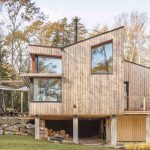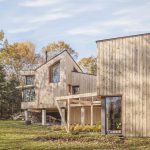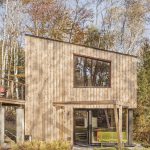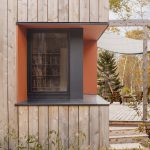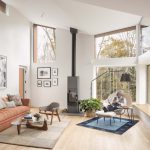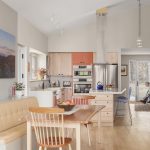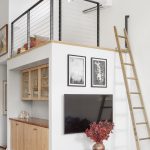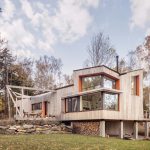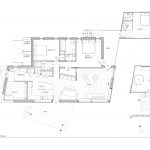Rockbound Park
Project Name
Completed 2018
1,750 square feet
Construction cost approx. $650,000
Paul and Judy, our clients from Buffalo, NY wanted a modest, low maintenance and net zero energy home to retire in ease and comfort, energy independent, and protected from future unknowns. Judy, an art conservator with some great pieces and very specific ideas on how to protect them, also needed a studio. We started the design on a narrow lot with these conditions in mind. Then the unexpected happened. Paul received a diagnosis of throat cancer, followed by surgery and (thankfully) recovery. This came with future living requirements, including needing to keep the house constantly at 60% humidity.
Due to these necessary environmental demands coupled with a super insulated home, a resilient, 16” deep section was developed, with a vapor barrier placed mid-wall and virtually uninterrupted behind all services. This ensures that the necessary levels of humidity that need to be maintained won’t cause rot within the assembly. Such thickness also provided an opportunity for dramatic juxtaposition as well as added function, allowing us to place windows both on the inner side and outer side of the wall. The deeply inset windows provide their own shade, a necessary piece of net-zero building, while windows flush with the exterior make space for deep sills and an integral wraparound window seat in the living room. Shading at the lower windows only is sensible in this unique case, the lines of which further accentuate the contrast.
From the street, it isn’t immediately apparent that a vibrant, light-filled space will emerge anywhere within this unassuming, untreated cedar shed, much less a detached studio down the hill, but the deeply recessed corner window provides a clue. The simplicity of two opposing roof planes allows a single, oversized dormer to distinguish itself, the first hint of which is revealed only after you walk into the space. While designing for ample passive solar, a swath on the south wall was reserved for a preservation-worthy piece of art above the dining nook, its back completely to the sun for protection.
The sloped nature of the land afforded us the opportunity to float the back part of the house on board-formed concrete piers which pay homage to the prevalent foundations of the island. Three outdoor seating areas allow distinctly different experiences of privacy and sun, as well as views into the adjacent woods and protected meadow. A 6.7 kW solar array provides all the capacity needed for its two residents to achieve net zero energy in this exceptionally airtight house (0.33 ACH50) approaching Passive House standards (5.14 kBTU/sf/yr).
Measure 1: Design for Integration
The primary design features were borne directly out of the durability and sustainability requirements. The necessary wall depth synchronized with the insulating and shading requirements to inspire a distinct building form.
Measure 2: Design for Community
One of the perks of island life is that this new house is in a walkable location, just a block from the water and loop road. The house itself is right on the road, public and familiar.
Measure 3: Design for Ecology
The landscape design is sustainable, incorporating native plantings that are resilient and with ecological storm water management on site.
Measure 4: Design for Water
Roof water is drained from a custom formed scupper, splashing the overflow into the lower level plantings. The rear of the home is raised, allowing natural drainage patterns to remain. Low-flow fixtures were installed throughout the house, and there is a heat pump water heater. The landscaping does not require watering.
Measure 5: Design for Economy
The form is essentially 2 shed roofs with a single dormer, and cellulose insulation. Simplicity help keep the costs reasonable, given that island homes usually come with a 30%+ construction premium attached.
Measure 6: Design for Energy
A 6.7 kW solar array provides all the capacity needed for its two residents to achieve net zero energy in this exceptionally airtight house (0.33 ACH50) approaching Passive House standards (5.14 kBTU/sf/yr). The home includes a fresh air ventilation system with heat recovery, ductless mini-splits, super-insulation, and triple-glazed windows.
Measure 7: Design for Wellness
Tall windows allow for daylight to reach deep into the house. All primary rooms feature cross ventilation. The windows, along with three varied outdoor seating areas, create connection with and possibility in the outdoors. There are low-VOC finishes throughout and it is a formaldehyde-free building.
Measure 8: Design for Resources
Locally-sourced materials were used for this build, and the builder herself is located on the island. The cedar planks on the exterior are naturally resistant to weather and insect damage, and a rain screen installed behind the planks prevents rot. Durability and low maintenance, particularly with the cold Maine winters, were an integral part of the design. The insulation used throughout the house has low global warming potential.
Measure 9: Design for Change
Passive solar, a reasonable skin-to-volume ratio, and super-insulation will keep this home comfortable for up to two (sunny) weeks in the event of a power outage.
Measure 10: Design for Discovery
The studio wasn’t designed until after the shell of the house was complete to give the homeowners a better sense of the land and a chance to see where their new favored spots might be, in terms of views, sun, shade, and privacy.



